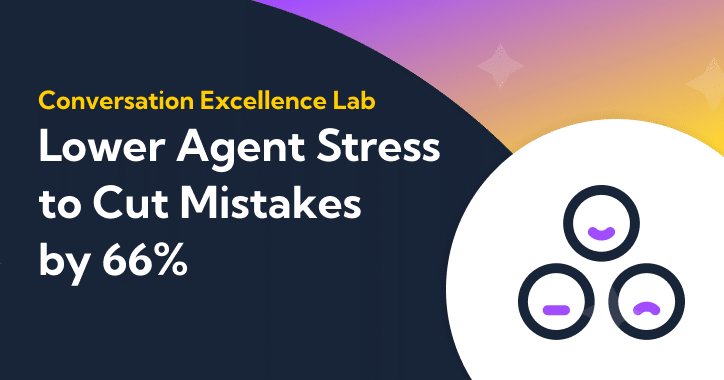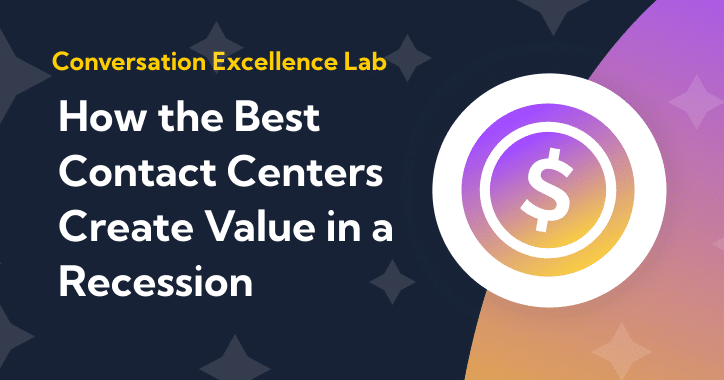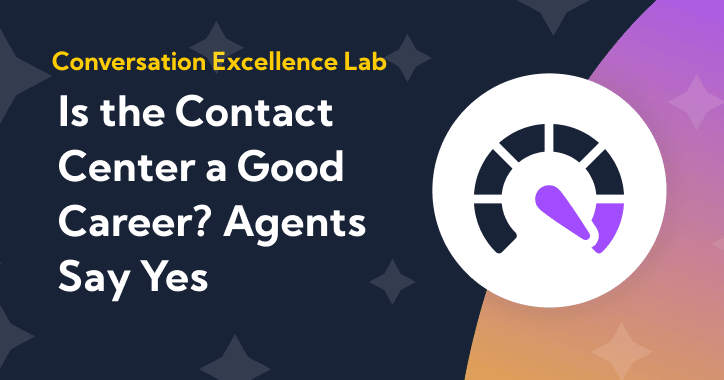Contact centers find themselves at a critical juncture. Economic conditions are pressing executives to find areas to save costs and operate more efficiently, while customer and prospect expectations are ever-rising and necessitate high-quality agent interactions.
Contact center leaders are tasked with creating as much value as possible with as few resources as possible, without sacrificing the customer or agent experience. How are they doing this? And what role does technology play?
We talked to over 400 contact center managers, directors, and executives to discover how they’re planning to do more with less in the coming year.
Here’s what we found:
- For 49.88% of contact center leaders, budgets aren’t going down — but they aren’t going up either. Companies are evaluating budget cuts in areas other than technology, which is seen as a deflectionary force against economic uncertainty.
- 64.27% of respondents feel more pressure now than they did last year. The industries feeling the most pressure are Transportation, Travel & Hospitality, Collections, Insurance, and Financial Services.
- Contact centers that prioritize AHT are under the most pressure, while the least under-pressure leaders emphasize a focus on CSAT instead.
- The utilization of AI technology has an inverse relationship with pressure levels — the more you use them, the less pressure you and your employees feel.
- Over 40% of our respondents said they were more interested in AI tools today than they were 12 months ago, and another 51% said they were just as interested now as before. Only 9% were less interested today than they were last year.
Get a Copy of the Report in Your Inbox
Read the results on your own time or share them with your team. No strings attached.
Subscribe for weekly insights from the Conversation Excellence Lab
Budgeting For Uncertainty in Contact Centers
Budgets in FY2023
We asked our respondents the following question: In the past 12 months, has your budget decreased, stayed the same, or increased?
Figure 1: Budget Change in the Past 12 Months
For 49.88% of respondents, budget hadn’t changed in the past year. This sounds good at first glance: for about half of respondents, budgets weren’t cut. But that means they didn’t grow either. When you’re running a company, you want it to grow every year, and if it grows, its budget will inevitably increase.
So, this 49.88% figure suggests three possibilities:
- Companies grew but resources didn’t grow alongside them.
- Companies did not grow.
- Budgets were cut in one area in order to allow for larger budgets in another area.
According to a Gartner survey, “real estate/facilities management” was the greatest target for budget cuts; 72% of CFOs wanted to trim their organization’s real estate footprint.
Technology, on the other hand, is generally one of the safest categories when it comes to cuts — it is a deflectionary force, a “must” under any economic climate to help fight inflation. “You are sacrificing the future if you opt out of AI completely,” said Reid Hoffman, Greylock partner.
Don’t spend across the board, but what are the expenses necessary for playing offense and not giving up key optionality? … Not retrenching and giving up the leaning curve that could cause your business to thrive. … You need to make sure you can continue to play, that’s the defensive game, but immediately after that it’s go to offense. It doesn’t mean cut every last dollar.
– Reid Hoffman, Greylock Partner
For 35.24% of respondents, a little over a third, budgets did grow. On the other end of the spectrum, 14.89% of respondents saw their budget decrease in the past 12 months.
We wanted to understand why budgets may have increased or decreased. For those whose teams decreased their budgets, 60% reported doing so as a result of company-wide budget cuts. Another 22.5% of budgets decreased because of team or company underperformance. Only 10% of budget decreases were a result of increased performance efficiency.
Business is still growing but funds for HR are not. If someone leaves or is let go, I’m not able to replace them at this time. Questionable looming recession has stopped any increases to our budget at this time.
– Survey Respondent
Figure 2: Reasons for Budget Decreases
Even if companies did find efficiencies and were able to lower their spend, these savings were often put toward other expenses.
In terms of budget increases, 30.99% were because a team was meeting its performance goals and requested more budget in order to perform even better. Another 30.17% percent of respondents increased their budgets because their company’s revenue grew accordingly. 28.10% saw a budget increase because their team increased in size.
Figure 3: Reasons for Budget Increases
Only 7.44% of budget increases were because a team wasn’t doing well and needed more resources, and only 3.31% received more funding because their team size had decreased and they needed more support in order to do more with fewer people.
Team budget increases did happen in the last year, but only for companies that were doing well to begin with. Teams in dire straits did not often see their budgets increased to help get them back on track. Those 49.88% whose budgets did not change have to do the same work with their existing budget, which may be frozen or otherwise more difficult to access in times of uncertainty.
Budget changes had an effect on agent satisfaction, which was an average of 4.01/5 for those who increased their budgets last year. Respondents whose budgets stayed the same saw an agent satisfaction average of 3.64/5, and those whose budgets fell had that average drop down to 3.30/5.
Budgets in FY2024
We also asked contact center leaders how they expected their budget to trend in the next 12 months.
Figure 4: Budget Change in the Next 12 Months
52.85% of our respondents anticipated that their budgets would stay the same — an increase from 49.88% whose budgets stayed the same in the past 12 months. 38.21% projected that their budgets would increase (up marginally from 35.24%), and 8.93% projected that their budgets would decrease (down from 14.89%).
But this sentiment was not shared across the board: the biggest companies and the smallest companies reported the lowest projections of budget increases. 17.07% of those at companies with fewer than 20 employees projected that their budget would increase in the next 12 months, along with 15.79% of those at companies with over 10,000 employees. The 101-10,000 employee range showed the most optimism; between 42-50% of respondents predicted that their budgets would increase in the next year.
Figure 5: Budget Increases in the Next 12 Months by Company Size
Interestingly, AI tool utilization made a difference in budget projections. 49.40% of those who actively used AI tools forecasted a budget increase in the next 12 months, compared to only 30.38% of those who did not. This may be because companies using AI were already doing well and anticipated that they would continue doing so, or because the onboarding of AI tools made a difference in their performance and therefore their budget trajectory.
The Landscape of Layoffs
14.89% of respondents said that their budget decreased in the last 12 months. This comes at a time when 28.13% of our respondents reported doing layoffs in the last year.
There is a clear discrepancy here. A significant percentage of the companies that did layoffs — 47% — did not do so because of budget cuts. They likely did so as a defensive measure as they faced economic ambiguity ahead.
More than a quarter (28.91%) of those who reported doing layoffs actually reported an increase in their budget in the last 12 months, not a decrease.
On average, those who did layoffs let go about 33% of their agents. Losing a third of a contact center’s workforce has an unignorable effect. We asked our respondents about the pressure they were feeling, and 84.37% of respondents who experienced layoffs said they agreed or completely agreed that they felt more pressure now than they did last year. This can be compared to 54.91% who didn’t experience layoffs.
A survey of 4,000 employees found that 74% of employees who kept their jobs amidst a layoff felt that their own productivity had declined as a result. Another 61% felt that their company’s future prospects were worse, and 87% said they were less likely to recommend their organization as a great place to work.
Dear CEOs: mass layoffs are counterproductive… firms that downsize end up being less profitable than peers that find other ways to lower costs (e.g., exec pay cuts, unpaid leaves). Layoffs bleed talent and breed guilt and anxiety. They should be the last resort.
- Adam Grant, Organizational Psychologist & Bestselling Author
But if the effects of a layoff are so onerous, then why would companies not experiencing budget cuts move forward with them? What are their priorities?
We asked respondents which metrics they were most concerned with, and their results varied when broken down by whether or not they had done layoffs. For example, those that did layoffs cared slightly less about customer satisfaction and customer retention than those who did not do layoffs — and significantly less about net promoter score (NPS). They did, however, care more about dials per week and average handle time. This suggests that those who do layoffs prioritize internal efficiencies, perhaps at the expense of the customer and agent experience.
It’s important to note that layoffs were not evenly distributed amongst respondents — 47.37% of those who worked at companies with over 10,000 employees had layoffs, as well as 46.15% of those who worked at companies between 1,001-5,000 employees. The lowest percentage of layoffs was 19.51% for companies with fewer than 20 employees.
Figure 6: Layoffs by Company Size
Of course, there are nuances to our conversation around budgets. A budget can stay the same but be frozen, be unfrozen but bureaucratically unusable, be usable but constricted in its applications. In our survey, we only asked if a respondent’s budget had gone up, gone down, or stayed the same, but the story is more varied than that.
What remains true, however, is that the budget metrics we did measure had a correlation with the pressure respondents felt in their day to day.
Efficiency is the Name of the Game
The Weight of Contact Center Pressure
How much do you agree with the following statement: Compared to last year, I feel increased pressure to do more with less.
If you somewhat or completely agree with that statement, you would be in the same boat as 64.27% of our respondents. Another 15.38% neither agreed nor disagreed with the statement, and 20.35% somewhat or completely disagreed.
It is just rumors and intuition right now. Inferences being made when listening to other executives speak. We are not laying anyone off, we have no plans to, but we are aware that things are tightening, so if we can find ways to reduce expenses, but keep profitability, we can save people's jobs. It is more of a warning of what could come, and what we don't want to come.
- Survey Respondent
Figure 7: Compared To Last Year, I feel Increased Pressure to Do More With Less
There was no statistically significant difference in pressure level by company size. The “least” pressured company size was 501-1,000 employees, where 54.67% of respondents said they felt pressure to do more with less. The “most” pressured were those at companies with fewer than 20 employees, where 73.17% felt this pressure.
Figure 8: Pressure To Do More With Less by Company Size
There were, however, differences by industry. The most pressured industries were Transportation, Travel & Hospitality, Collections, Insurance, and Financial Services. The least pressured industries were Home Improvement, Construction, and Retail.
Figure 9: Pressure To Do More With Less by Industry
For those that had budget cuts in the last year, 81.67% felt pressure to do more with less. But even among those whose budgets increased, 57.04% still felt this same pressure. Part of this pressure can be attributed to budget, then, but not all of it. Amidst economic uncertainty, increasing consumer demands, and the personnel changes, it's easy to feel like you have to do more in order to just keep up.
We asked our respondents where this pressure to do more with less was coming from. 31.95% said they had fewer people around to do the same amount of work, 31.12% pointed to a general environment and culture of pressure, 19.50% said they had less budget to work with, and 12.86% talked about economic pressure or the effects of inflation.
Figure 10: Types of Pressure To Do More With Less
PULL QUOTE: “Ever since the beginning of the pandemic, we showed how much we can do with or without certain resources — now they want us to maintain the same workload.” - Survey Respondent
Top Contact Center Tools & Priorities
In technical terms, efficiency refers to the ratio of work performed to total energy expended. When we talk about efficiency in a contact center, we’re asking: how do you tilt this ratio in your favor? With fewer resources and increased pressure, how can you make limited inputs go farther?
We asked our respondents which tools and strategies they’ve taken advantage of to help generate more efficiency in their contact center. The top tools used were agent training (46.65%), Customer Relationship Management (CRM) tools (42.68%), and knowledge bases (36.48%). Increasing headcount was number six in the lineup, and gamification tools came in last place at only 9.43%.
Figure 11: Utilization of Efficiency Tools
When resources are limited, leaders also have to decide which metrics are most worth investment. The metrics that our respondents looked at most closely were Customer Satisfaction (CSAT) Score (55.83%), Customer Retention Rate (CRR) (39.21%), and Average Handle Time (36.97%). The least important metrics were Dials Per Week (DPW) (17.12%), Cost Per Call (CPC) (16.38%), and Net Promoter Score (NPS) (12.9%).
All three top metrics point towards an emphasis on the customer experience. Are customers staying around for the long term? Can we solve their problems as quickly and effectively as possible?
It’s interesting that NPS was the least important metric to our respondents, as it's been an integral part of customer success strategy for over two decades. This could be because of industry differences in key metrics. Not all industries value NPS or use it to measure their brand’s perception, and some may opt to use another similar metric instead, like CSAT, which measures customer satisfaction with individual service experiences.
NPS can still be valuable as a way to see if you are meeting the expectations of consumers — when the results are positive. It’s when the results aren’t where they should be that NPS falls short, indicating something is broken but giving little insights as to where along the way the experience faltered. I believe today’s customer journey has become too complex and nuanced for this measurement to handle on its own.
- Janelle Dieken, Senior Vice President of Genesys
We found some interesting data as well when it came to the relationship between key metrics and pressure. Those who felt the greatest pressure to do more with less also had the greatest focus on average handle time (AHT). They wanted to make calls shorter and make as many of them in a day as possible.
Those who felt the least pressure to do more with less had the greatest emphasis on customer satisfaction (CSAT) scores — they wanted their customers to have exceptional experiences and interactions with their company. 76.92% of those who did not feel any pressure to do more with less were closely following CSAT — compared to 54.95% of those who felt overwhelming pressure.
How do AHT and CSAT function alongside one another? Can you make a call as short as possible without losing that positive customer experience? The answer to these questions will vary tremendously based on industry, use case, and the company itself. But technology can certainly help.
Artificial Intelligence Can Bridge The Efficiency Gap
Defining Contact Center AI
Among our respondents who reported feeling no pressure to do more with less, 57.69% of them were actively using AI technology. Among those who did feel the pressure to do more with less, only 34.52% were using AI technology. These findings are statistically significant: AI tool usage is inversely correlated with pressure among your workforce.
Technology is a potent way to unlock value, and it's a key investment area to avoid falling behind competition. In recent years, AI in particular has been at the forefront of contact center innovation.
But let’s take a step back: what’s the difference between AI technology and regular technology?
AI technology aims to mimic human behavior and abilities such as speech recognition, information processing, performance, adaptation, and more. Learning is a huge facet of AI — machine learning refers to AI’s ability to automatically learn from past data it has ingested without explicit instruction. Natural language processing, also a primary pillar of AI, is a process that turns text or audio speech into information that can then be read by other programs. Finally, generative AI takes in large amounts of data in order to generate images, audio, text, art, and more.
Many, in fact, see call centers as the new sandbox for AI-powered customer experience — with an array of new and emerging tools that can boost retention, loyalty, and, ultimately, revenue and profit.
- Forbes
Some applications of AI in the contact center include: call guidance software, predictive call routing, sentiment analysis, personalization, chatbots, auto-notetaking, and more.
According to a 2022 research report, 85% of contact center professionals agree that AI technology is valuable and recognize the risks of not deploying it, including risks to customer satisfaction and potential losses in productivity.
AI in the Contact Center Today
Over 40% of our respondents said they were more interested in AI tools today than they were 12 months ago, and another 51% said they were just as interested now as before. Only 9% were less interested today than they were last year.
Among those whose budget increased in the last year, 64.08% were interested in AI, compared to 26.87% for those whose budgets stayed the same and 43.33% for those whose budgets decreased.
When people have resources, they want to invest in technology — specifically AI technology. This trend is clear, but does it translate to action?
Figure 12: AI Tool Utilization in Contact Centers
The majority of our respondents (59%) were not using AI tools today. But of this 59%, a little less than half (45%) were actively planning to implement an AI tool in the next 12 months, with another 16% saying they were interested in doing so and needed support from leadership.
Figure 13: Breakdown of AI Tool Utilization and Attitudes
In 2020, the global market for AI in contact centers was estimated at $1.1 billion — by 2026, that figures is estimated to reach $3.5 billion.
Those who were most interested in using AI tools today versus last year actually occupied opposite ends of the spectrum when it came to the pressure. Of those who felt absolutely no pressure, 69.23% were more interested in AI today than they were in the past. Of those who felt a tremendous amount of pressure, 53.84% were more interested in AI today than they were in the past. All responses in between those two showed lower levels of AI interest.
Figure 14: AI Utilization Interest by Pressure to do More With Less
It seems that those who are not under pressure are more interested in AI because they have the bandwidth to look forward and innovate, while those under the most pressure are more interested in AI because they hope it can be a life raft. And when wielded correctly, it can be.
AI tool usage also varied by company size. Companies with fewer than 100 employees had the lowest prevalence of AI tool usage, and then usage evened out in the 40-60% range after a company reached 101 employees, peaking at 64.10% usage at the 1,001-5,000 employee size range.
Figure 15: AI Tool Utilization by Company Size
AI tool usage varied by industry as well. The industries with the highest usage of AI tools were Telecommunications (88.24%), Technology (69.7%), Retail (60%), Construction (55.56%), and Healthcare (54.55%). The industries that used AI the least were Travel and Hospitality (13.33%), Insurance (16.67%), Government and Non-Profit (20%), Logistics (33.33%), and Transportation (37.50%).
Figure 16: AI Tool Utilization by Industry
For the respondents who were currently using AI tools, the prognosis was positive. The average effectiveness score of this technology was rated as a 4 out of 5 when it came to increasing company efficiency and ROI.
Only 6.3% of respondents stopped using AI technology because it was too difficult to implement or utilize. For the most part, our respondents found these tools intuitive, user friendly, and easy to use.
The data above supports the idea that contact centers have a generally positive view of AI tools and technologies, and view them as a significant pathway to generate more efficiency without simply hiring more people.
The Limitations of AI Technology
We asked the 58.8% of our respondents who weren’t currently using AI technology a follow-up question: Why not?
The most common answer (39.19%) was that they were planning on implementing it in the next 12 months, they just hadn’t done so yet. In total, 67.5% of respondents were either actively using or planning to implement AI technology in their contact centers.
Figure 17: Why Don’t You Use AI Technology Today?
The next most common reason that respondents didn’t use AI technology was that they simply weren’t interested (16.48%). Some contact center leaders resist the perceived operational lift of implementing a new technology, or turn away from AI technology because they don’t understand its underlying mechanics. Some may also believe that, to protect their agents' livelihoods, they need to keep the agent’s job as manual as possible.
But this is not the case. The best AI augments the agent experience, allowing agents to be present on calls with all of the information they need at their fingertips. It also allows supervisors to more efficiently and proactively train, mentor, and QA their team.
The most common misconception is that AI is complicated and expensive. Although it was true a decade ago, it certainly isn’t the case anymore… AI has become very democratized in a way that anyone can use it in order to improve their business processes. Another misconception is that we often see AI as a solution looking for a problem, where it should actually be the opposite. We should know what the problems are and then apply AI to solve those problems.
- Alain Mowad, Director of Product Marketing at Talkdesk
It’s hard to overcome common misconceptions around AI. 14.29% of those who didn’t use AI said that they were interested in doing so but had experienced pushback from their colleagues or superiors. Another 13.92% said that they couldn’t get the budget approved.
Only around 5% said that the technology was too difficult to implement. A little over 10% of respondents said that they had used AI tools in the past and didn’t see the ROI. Not all AI is created equally, and it’s critical to do your research and get the proper internal buy-in for a new technology to make a real difference in your organization.
For the most part, those who aren’t using AI today are planning on doing so in the next year. The remainder had slightly different challenges, like overcoming their own misconceptions around AI or those of their team. Unlocking ROI is a process with any new technology, AI or otherwise, and requires deep needs analysis and due diligence on the back-end as well as a thorough change management plan on the front end when it's time for implementation.
New AI: Automating After-Call Work (ACW)
The most recent innovations in AI technology in the contact center have centered around generative AI, and its applications for after-call work (ACW). ACW encompasses the activities that an agent performs after each and every call. These activities vary by industry and use case but generally include things like:
- Typing up a call summary
- Putting call notes into another system or tool
- Updating fields in another system or tool
- Assigning a call a disposition code or representative label
- Assigning another employee to follow up on a call action
- Analyzing customer feedback
- Other post-call activities
Figure 18: Breakdown of Respondent ACW
The most common ACW among our respondents was putting call notes into another system or tool, like a CRM (52.97%), followed by typing up a thorough, compliant call summary (42.08%). The least common parts of after-call work were assigning another employee to follow up on an action (25.25%) and assigning a call a disposition code (31.44%). Only 5.45% of our 400+ respondents reported doing no after-call work at all.
The average amount of ACW done per call was 10.74 minutes, and this number varied dramatically by industry. The industry with the most ACW was transportation at 22.59 minutes. The industries with the least amount of ACW were travel and hospitality (7.41 minutes) and collections (8.71 minutes).
ACW also shows variance by company size. Those at companies with fewer than 20 employees spent the least amount of time on ACW at 10.73 minutes on average. The most time was spent on ACW at companies with 1,001-5,000 employees at 21.23 minutes. This makes sense, as larger companies often have more processes and procedures in place.
Interestingly, agent attrition showed a positive correlation with ACW. We asked respondents what percentage of their agents churned every year and compared that to the average ACW they reported per call. Those with the lowest reports of ACW reported a 26.67% annual agent attrition rate, compared to 47.25% for those with the most ACW.
Figure 19: The Relationship Between ACW and Agent Attrition
ACW can have an outsized impact on an agent’s day-to-day workload. Let’s consider this hypothetical scenario:
- You have 300 agents
- Each agent makes 40 calls a day
- Each agent works 20 days out of the month
- Each agent gets paid $15/hour
If you were able to automate the process of typing a call summary, which takes about a minute per call, you would save each agent 40 minutes a day. You would also save your company $60,000 a month or $720,000 a year. What could you do with that additional bandwidth and money? What additional efficiencies could you drive?
Conclusion
Efficiency is the word of the year. Budgets aren’t necessarily decreasing but they aren’t increasing either. Contact centers need to create value and discover efficiencies in ways that go farther than simply throwing more people at a problem. As economic uncertainty continues, contact centers aren’t rushing to hire more people or backfill roles. Instead, they’re turning towards technology to drive efficiencies.
AI technology, to be specific. People are more interested in investing in AI than ever before, and 67.5% of our 400+ respondents were either actively using or about to implement AI technology. What was cutting-edge is now becoming table stakes: even as budget cuts are made across organizations, technology remains heavily invested in. When applied correctly, technology investment is a deflectionary measure that keeps your organization ahead of its competitors, increases agent satisfaction, and drives savings.
Demographics
We surveyed 403 contact center leaders for this survey. We only allowed respondents with titles of manager, director, or above to participate in this survey. The tenure range for participants was < 6 months to 10+ years, with an average tenure of 8.11 years.
Figure 20: Tenure Breakdown of Respondents
Ages also ranged among respondents. The most represented age groups were 34-44 (39.95%) followed by 25-34 (23.08%) and 45-54 (23.08%). The average age was 42.14 years old. The gender breakdown was 62.03% male and 37.97% female.
Figure 21: Age Breakdown of Respondents
The most represented use case was Operations (45.66%) followed by Customer Service (29.28%), and the least represented use case among respondents was Collections (1.49%). We received respondents from a wide range of industries as well. The most represented industries in our survey were Healthcare (10.92%), Technology (8.19%), and Manufacturing (8.19%) and the least represented industries were BPOs (0.25%), Home Improvement (0.99%), and Utilities (0.99$).
Figure 22: Industry Breakdown of Respondents
Pie Chart, Lior’s Scrap Tab
Respondents worked in contact centers with fewer than twenty agents (10.17%) all the way to 10,001+ agents (4.71%). The most represented company size was 101-500 agents (30.02%) and the least represented size was 5,001-10,000 (2.48%).
Figure 23: Company Size Breakdown of Respondents
Methodology
This research was conducted in collaboration with third-party research firm Centiment in March 2023. Survey participants were given a screening question to determine whether or not they fit into the criteria for participation in the survey: “Which of the following best describes your job?” If their response did not signify that they were a manager, director, vice-president, or c-suite of a contact center, they were disqualified.
Respondents were then given 26 questions. 18 questions centered around their contact center’s budget, resources, interest in AI, pressure, technology utilization, and more. The remaining questions were of a demographic nature and respondents were asked to self-report on their gender, age, tenure, industry, etcetera. The survey included an attention check at the midpoint to ensure that respondents were fully attending to the content of the survey.
The sample population spanned a wide range of executive experience levels, industries, departments, age groups, and other demographic parameters.
Sources
Balto. (2021, January 11). 2021 Contact Center Agent Survey Report - Balto Ai. RSS. Retrieved May 2nd, 2023, from https://www.balto.ai/research/2021-agent-report/
Balto. (2021, June 21). Natural Language Processing: How Machines Are Getting Better at Human Language - Balto Ai. RSS. Retrieved May 2nd, 2023, from https://www.balto.ai/blog/natural-language-processing-how-machines-are-getting-better-at-human-language
Balto. (2022, February 6). Is the Contact Center a Good Career? Tenured Agents Say Yes - Balto Ai. RSS. Retrieved May 2nd, 2023, from https://www.balto.ai/research/is-the-contact-center-a-good-career
Balto. (2022, April 4). KPI Series: How to Reduce Your Call Center Average Handle Time - Balto Ai. RSS. Retrieved May 2nd, 2023, from https://www.balto.ai/blog/reduceyour-average-handle-time-aht
Balto. (2022, March 29). Contact Center Attrition: What Agents Want in 2022 - Balto Ai. RSS. Retrieved May 2nd, 2023, from https://www.balto.ai/research/contact-center-attrition-2022/
Balto. (2022, August 3). How to Recession-Proof Your Contact Center - Balto Ai. RSS. Retrieved May 2nd, 2023, from https://www.balto.ai/research/how-to-recession-proof-your-contact-center/
Balto. (2022, October 31). How to Fix Onboarding, According to 400+ Contact Center Employees - Balto Ai. RSS. Retrieved May 2nd, 2023, from https://www.balto.ai/research/how-to-fix-contact-center-onboarding/
Balto. (2023, March 20). Automating After-Call Work: How to Increase Agent Efficiency with Real-Time Notetaker - Balto Ai. RSS. Retrieved May 2nd, 2023, from https://www.balto.ai/blog/automate-after-call-work-and-increase-agent-efficiency-with-real-time-notetaker/
Bannon, L. (2023, February 18). AI in the Workplace Is Already Here. The First Battleground? Call Centers. The Wall Street Journal. Retrieved May 2nd, 2023, from https://www.wsj.com/articles/ai-chatgpt-chatbot-workplace-call-centers-5cd2142a
Beasley, C. (2022, July 11). 79% of CX Leaders Plan to Increase Investment in Contact Center AI and Automation. BusinessWire. Retrieved May 2nd, 2023, from https://www.businesswire.com/news/home/20220711005291/en/79-of-CX-Leaders-Plan-to-Increase-Investment-in-Contact-Center-AI-and-Automation
Call Centre Helper. (2022, February 15). Why an AI-Powered Contact Centre Will Never Replace Human Agents. Call Centre Helper. Retrieved May 2nd, 2023, from https://www.callcentrehelper.com/ai-powered-contact-center-203947.htm
Crouse, M. (2023, March 22). Employees want more training on AI tools before using them for work. TechRepublic. Retrieved May 2nd, 2023, from https://www.techrepublic.com/article/employee-training-ai-tools-chatgpt/
CX Central. After Call Work. CX Central. Retrieved May 2nd, 2023, from https://cxcentral.com.au/glossary/after-call-work/
Dieken, J. (2022, September 26). Is the Net Promoter Score dead? Why it may be time to look beyond this metric. Fast Company. Retrieved May 2nd, 2023, from https://www.fastcompany.com/90789303/is-the-net-promoter-score-dead-why-it-may-be-time-to-look-beyond-this-metric
Gartner. (2019, November 5). 6 AI Myths Debunked. Gartner. Retrieved May 2nd, 2023, from https://www.gartner.com/smarterwithgartner/5-ai-myths-debunked
Grant, A. (2023, February 4). Dear CEOs: mass layoffs are counterproductive. Hundreds of studies: firms that downsize end up being less profitable than peers that find other ways to lower costs (e.g., exec pay cuts, unpaid leaves). Layoffs bleed talent & breed guilt+anxiety. They should be the last resort. [Tweet]. Twitter. Retrieved May 2nd, 2023, from https://twitter.com/AdamMGrant/status/1621945252473880582?s=20&t=5AWSManvFuC7MfXnMKZMDw
Genesys. (2019, August 27). AI Ethics: Fighting The Fear Of AI In The Workplace. Genesys. Retrieved May 2nd, 2023, from https://www.genesys.com/blog/post/ai-ethics-fighting-the-fear-of-ai-in-the-workplace
Hellsten, K. (2020, June 12). How AI Can Alleviate Call Center Stress Amid Business Disruptions. Spiceworks. Retrieved May 2nd, 2023, from https://www.spiceworks.com/collaboration/telephony/guest-article/how-ai-can-alleviate-call-center-stress-amid-business-disruptions/
IBM. What is machine learning? IBM. Retrieved May 2nd, 2023, from https://www.ibm.com/topics/machine-learning
IBM AI Insights Contributor. (2020, June 25). How AI Is Revamping the Contact Center. Forbes. Retrieved May 2nd, 2023, from https://www.forbes.com/sites/insights-ibmai/2020/06/25/how-ai-is-revamping-the-call-center/?sh=13715c334b2b
International Customer Management Institute. The Contact Center Workforce of the Future. ICMI. Retrieved May 2nd, 2023, from https://www.icmi.com/-/media/files/resources/research/q32021-execsum-workforce-future.ashx?la=en&hash=57967E5936871DDA19496279BE6057C5419DA01F
Leachman, L., & Scheibenreif, D. (2023, March 17). Using Technology to Create a Better Customer Experience. Harvard Business Review. Retrieved May 2nd, 2023, from https://hbr.org/2023/03/using-technology-to-create-a-better-customer-experience
Leadership IQ. Don't Expect Layoff Survivors To Be Grateful (Survivor’s Guilt After A Downsizing). Leadership IQ: A Mark Murphy Company. Retrieved May 2nd, 2023, from https://www.leadershipiq.com/blogs/leadershipiq/29062401-dont-expect-layoff-survivors-to-be-grateful
Mascarenhas, N., & Stringer, A. (2023, April 7). A comprehensive list of 2023 tech layoffs. TechCrunch. Retrieved May 2nd, 2023, from https://techcrunch.com/2023/04/07/tech-industry-layoffs/
McKendrick, J. (2022, December 23). Artificial Intelligence’s Paradoxes: Easy But Hard To Implement, Lacking Talent But Easing Talent Shortages. Forbes. Retrieved May 2nd, 2023, from https://www.forbes.com/sites/joemckendrick/2022/12/23/artificial-intelligences-paradoxes-easy-but-hard-to-implement-lacking-talent-but-easing-talent-shortages/?sh=6140f33d6c78
McKinsey & Company. (2023, January 19). What is generative AI? McKinsey & Company. Retrieved May 2nd, 2023, from https://www.mckinsey.com/featured-insights/mckinsey-explainers/what-is-generative-ai
Mowad, A. (2022, June 27). ‘AI Misconceptions are Slowing Down Adoption’ – Talkdesk. CX Today. Retrieved May 2nd, 2023, from https://www.cxtoday.com/contact-centre/ai-misconceptions-are-slowing-down-adoption-talkdesk/
Piñon, N. (2023, January 4). ‘Quiet hiring’ will dominate the U.S. in 2023, says HR expert—and you need to prepare for it. CNBC. Retrieved May 2nd, 2023, from https://www.cnbc.com/2023/01/04/gartner-hr-expert-quiet-hiring-will-dominate-us-workplaces-in-2023.html
Rosenbaum, E. (2022, June 28). The corporate spending that can’t wait for a recession to pass. CNBC. Retrieved May 2nd, 2023, from https://www.cnbc.com/2022/06/28/the-corporate-spending-that-cant-wait-for-a-recession-to-pass.html
Rosenbaum, E. (2022, August 5). Where companies say they will cut budgets first in a softer economy. CNBC. Retrieved May 2nd, 2023, from https://www.cnbc.com/2022/08/05/where-companies-say-they-will-cut-budgets-first-in-a-softer-economy.html
Rush, L. (2022, April 1). How To Rate Call Center Effectiveness. Forbes. Retrieved May 2nd, 2023, from https://www.forbes.com/sites/forbesbusinesscouncil/2022/04/01/how-to-rate-call-center-effectiveness/?sh=304144005e2a
Qualtrics. Contact center artificial intelligence: How to supercharge customer interactions. Qualtrics. Retrieved May 2nd, 2023, from https://www.qualtrics.com/uk/experience-management/customer/contact-centre-artificial-intelligence/
Qualtrics. What is CSAT and how do you measure it? Qualtrics. Retrieved May 2nd, 2023, from https://www.qualtrics.com/experience-management/customer/what-is-csat/
Qualtrics. What is NPS? Your ultimate guide to Net Promoter Score. Qualtrics. Retrieved May 2nd, 2023, from https://www.qualtrics.com/experience-management/customer/net-promoter-score/
Wood, L. (2022, March 1). Global Call Centers Artificial Intelligence (AI) Market Trajectory & Analytics, 2020-2021 & 2022-2026 - ResearchAndMarkets.com. BusinessWire. Retrieved May 2nd, 2023, from https://www.businesswire.com/news/home/20220301005933/en/Global-Call-Centers-Artificial-Intelligence-AI-Market-Trajectory-Analytics-2020-2021-2022-2026---ResearchAndMarkets.com
Yarcony, R. (2023, January 30). 2023 Can Be Your Opportunity To Manage Workplace Stress. Forbes. Retrieved May 2nd, 2023, from https://www.forbes.com/sites/forbesbusinesscouncil/2023/01/30/2023-can-be-your-opportunity-to-manage-workplace-stress/?sh=6803b131b0bb






